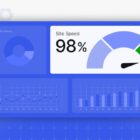Six months ago, Google announced its plans to introduce a new ranking signal for Search, based on page experience as measured by Core Web Vitals metrics. At that time, Google promised to give site owners at least six months notice before rolling out the update so they can improve their scores on the metrics before the update. The company reports a 70% increase in users engaging with Lighthouse, PageSpeed Insights, and Search Console’s Core Web Vitals report in preparation for the update.
Today Google confirmed that it will roll out the new page experience signals in May 2021. The search engine also plans to introduce a new visual indicator for pages that fully comply with the page experience requirements:
On results, the snippet or image preview helps provide topical context for users to know what information a page can provide. Visual indicators on the results are another way to do the same, and we are working on one that identifies pages that have met all of the page experience criteria. We plan to test this soon and if the testing is successful, it will launch in May 2021 and we’ll share more details on the progress of this in the coming months.
There are no additional details on what that will look like but AMP’s lightning bolt is a good example of how small graphics can have a meaningful impact on users’ behavior when navigating through search results.
The page experience signals Google plans to roll out will include Core Web Vitals (Loading, Interactivity, and Visual Stability metrics), combined with existing search signals for mobile-friendliness, safe-browsing, HTTPS-security, and intrusive interstitial guidelines. Based on where the web is now, in terms of delivering a good page experience (as defined by Google), site owners will undoubtedly need the next six months lead time to become aware of the new ranking signal and prepare.
Google’s Core Web Vitals assessment gives a pass or fail rating, with a “pass” requiring a good result in all three metrics. A cursory test using Page Speed Insights on a few of the websites for the largest companies, hosts, and agencies in the WordPress space shows most of them do not currently meet these requirements.

In August, Screaming Frog, a search marketing agency, published a lengthy report on tests that found only 12% of Mobile and 13% of Desktop results passed the Core Web Vitals assessment. Screaming Frog used the PageSpeed Insights API to test 20,000 websites, which were selected through scraping the first-page organic results from 2,500 keywords across 100 different topics. The report highlighted a few important findings:
- First Input Delay (FID) on Desktop is negligible with 99% of URLs considered good. And 89% for Mobile.
- 43% of Mobile and 44% of Desktop URLs had a good Largest Contentful Paint (LCP).
- 46% of Mobile and 47% of Desktop URLs had a good Cumulative Layout Shift (CLS).
- URLs in Position 1 were 10% more likely to pass the CWV assessment than URLs in Position 9.
These results suggest that most website owners still have a good deal of work ahead of them in meeting the requirements for passing the Core Web Vitals assessment. Unsurprisingly, Google suggests AMP as the preferred vehicle to get there, but even AMP is not a magic bullet.
At AMP Fest last month, the project reported that 60% of AMP domains pass the Core Web Vitals metrics (meaning 75% of pages on the domain passed), compared to 12% of non-AMP domains passing based on the same criteria.
“Looking ahead to Google Search’s upcoming rollout of using page experience signals in ranking, we challenged ourselves to consider how we could better support the AMP community and reach a point where we are able to guarantee that all AMP domains meet the criteria included in the page experience ranking signal,” AMP Product Manager Naina Raisinghani said.
Those who are already using AMP are encouraged to check out the AMP Page Experience Guide, a diagnostic tool that helps developers improve their page experience metrics with practical advice.
AMP is not required, however, if developers feel confident delivering the kind of performance metrics necessary to pass the Core Web Vitals assessment. Along with the new ranking signal, Google also plans to roll out another promised change that allows non-AMP content to become eligible for placement in the mobile Top Stories feature for Search. Starting in May 2021, sites that can deliver decent page experience metrics will be prioritized, regardless of whether they were built with AMP or through some other means.





